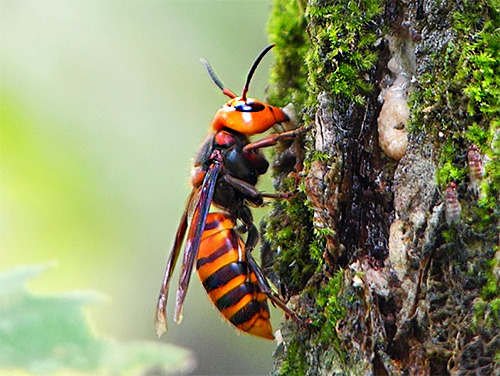
Japanese huge hornet is a close relative Hornet ordinaryliving in our country. But despite this, the difference in appearance and size between these insects is huge.
Comparing them, you can see that the Japanese hornet is different from its European counterpart in color, however, this is not its main characteristic. Dimensions - this is what this giant can boast of. This insect wears its name “giant Japanese hornet” for a reason: its length can exceed 4 cm, and its wingspan is 6 cm.
The photo below shows the Japanese hornet (vespa mandarina japonica):
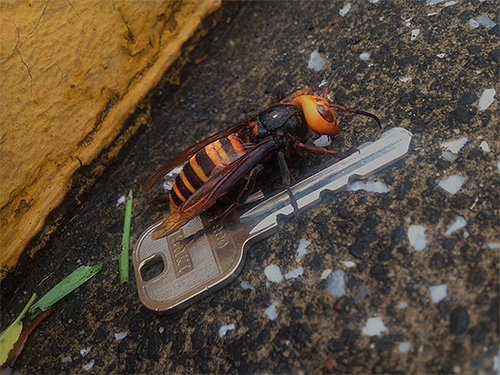
And this is how an ordinary hornet (Vespa crabro) looks like, which is widely distributed in Russia and Europe:
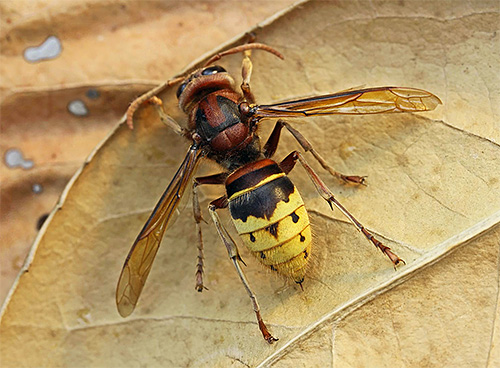
Perhaps the first thing that comes to mind at the sight of the Japanese "monster" is how dangerous it is and how painful its bite is.Really, giant hornet It has a very frightening appearance, which, however, accurately reflects the severity of the consequences of meeting it.
Japanese hornets can really be very dangerous: in the country that gave the name to these insects, more than 40 people die from their bites every year. All the people that this hornet has stinged ever claim that they have never experienced a more painful bite in their lives.
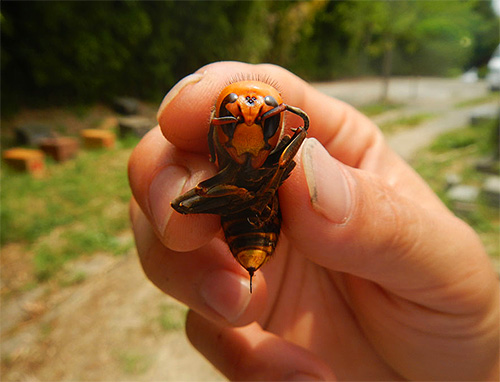
On a note
Virtually any meeting with the hornet, to whatever type he may belong, in one degree or another dangerous. Not surprisingly, medical scientists and biologists are very interested in the effect of the bites of these insects on the human body. It turned out that in nature one of the strongest is poison, which the giant Japanese hornet possesses: even with a single bite, it can cause a powerful allergic reaction right up to anaphylactic shock. When a mass attack of several hornets of this species occurs, a person can have severe hemorrhages and tissue necrosis.

When planning a trip to Japan, it is always useful to be prepared for a chance encounter with giant hornets and to know not only what they look like, but also how to behave so that insects do not attack.
What does the huge Japanese hornet look like?
Generally speaking, giant hornets in Japan are a subspecies of the giant Asian hornet. These insects are found only on the Japanese islands, being classic endemics.
Despite its impressive size, the giant Japanese hornet is still somewhat inferior in this respect to the continental wasps to the scoliums: these insects are even larger. Scolia is considered the largest wasp in the world.
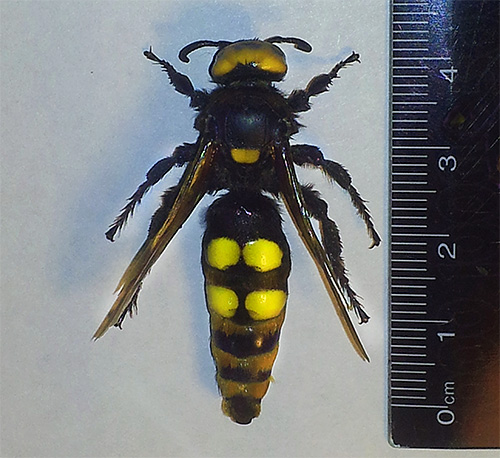
However, the Japanese hornet is not small (especially in comparison with other species) - in the photo below you can estimate its size compared to the palm of a person:
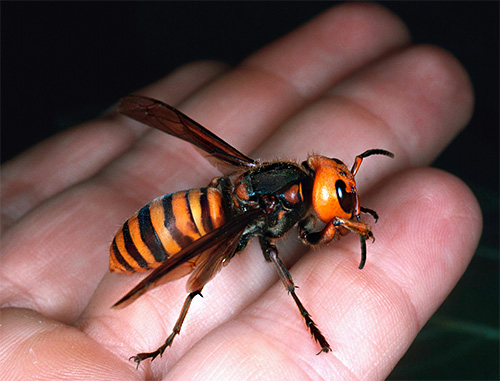
The length and wingspan of the Japanese giant hornet is its main difference from most other species of the Hornets. Even in comparison with those of them that have a similar color, the Japanese giant is more striking because of the simple relationship between the size of the body and the size of the flowers and branches on which it is found.

The color of the Japanese giant hornet is another characteristic of it. The insect has a black chest, a yellow head and the same color of the base of the abdomen, which is drawn from the middle with transverse brown and black stripes. Such a picture makes it easy to distinguish this huge wasp from the usual Europeanhornets - in the domestic species, the posterior half of the abdomen is monotonously yellow.
A close-up picture of a Japanese hornet:
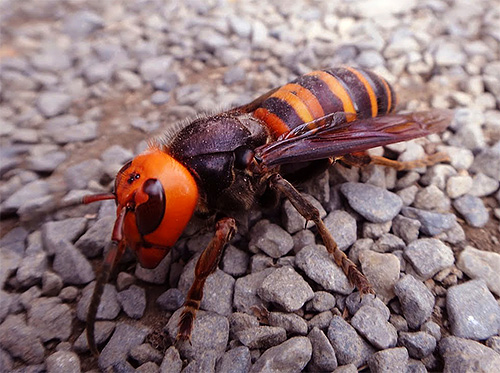
And for comparison photo of the hornet ordinary:

The giant hornet has two clearly visible large eyes on the front of the head, and a little higher than them - three additional small accessory eyes, providing a large viewing area (see photo).
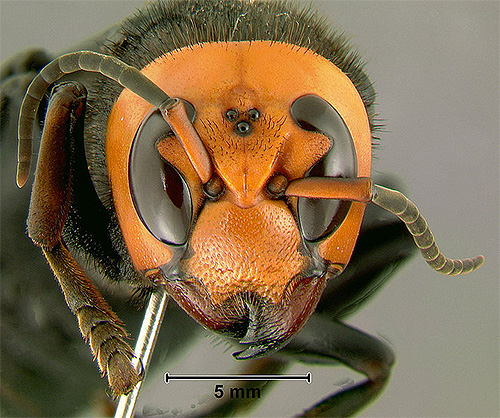
In general, all the hornets in the world - and European, and Japanese, and beautiful yellow Vespa bicolor - despite some distinctive features, are in the same degree of kinship and belong to the family of these wasps. For this reason, their lifestyle, diet, and biology are very similar.
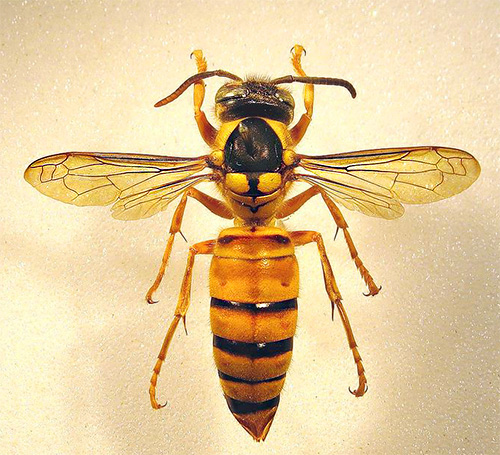
On a note
Sometimes the Japanese hornet is incorrectly called the eastern one. In fact, the eastern hornet (Vespa orientalis) is a separate species, common, for example, in southern Europe, in subtropical regions of Asia, and also in North Africa, and adapted to dwelling in a dry climate. These insects nest in the ground.
Below is a photo of an eastern hornet (Vespa orientalis):
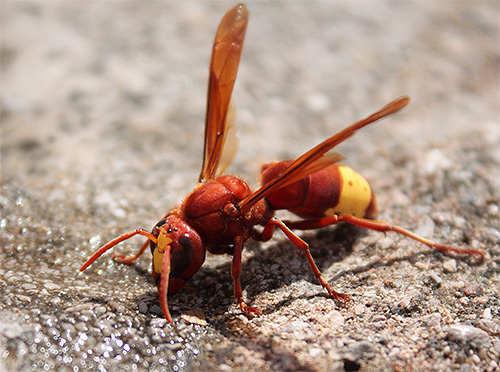
Huge wasp life
As already mentioned, the Japanese huge hornet is a strict island endemic.Outside Japan, it was found only in the south of Sakhalin. On the mainland, this species does not occur at all.
As for lifestyle, the Japanese giant lives in almost all biotopes, except the alpine belt and large cities. Where insects live, there are almost no drafts and other disturbing factors: their nests are located on the branches and hollows of trees, under the roofs of rural buildings, on the ledges of rocks in the forest zone, in the cracks of stones and natural niches.
A huge hornet builds dwellings that are very similar to paper nests of wasps, only larger and larger ones. Such a structure and location of the dwellings of these insects is characteristic of almost all other species of their relatives.
A young overwintered female builds the nest in early spring. She feeds the first larvae herself, and the working hornets that emerge from them begin to help the founding female to get food and take care of the brood. After a short time - as the colony grows - the uterus ceases to do anything other than laying eggs.
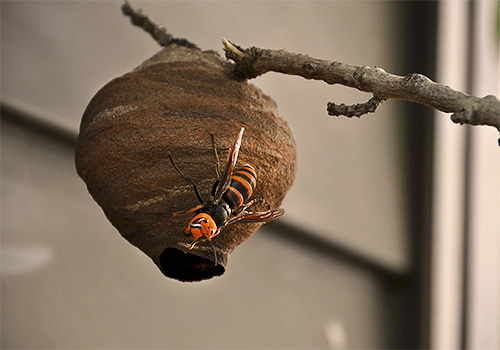
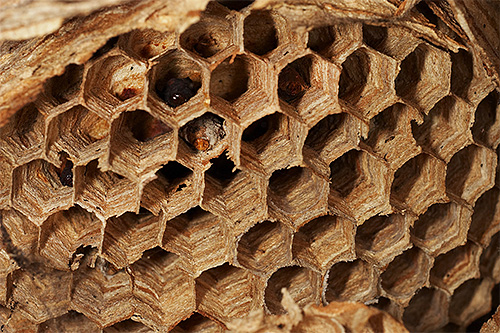
From the moment of egg laying until the hornet leaves the pupa, it takes about 28-30 days.
If we talk about the food preferences of this insect, it is worth noting that the Japanese giant hornet, however, like all of its close relatives is a predator. The main part of its diet consists of various insects, spiders, worms, mollusks.
However, like other wasps, the huge hornet loves honey, the juice of sweet fruits, and can also fly to the smell of meat and fish. He does not even refuse to start spoiling products.
Another thing - the larvae. Hornets feed their offspring exclusively with top-quality meat food - they give them the most tidbits of their prey.
The photo below shows the larvae of the Japanese hornet:
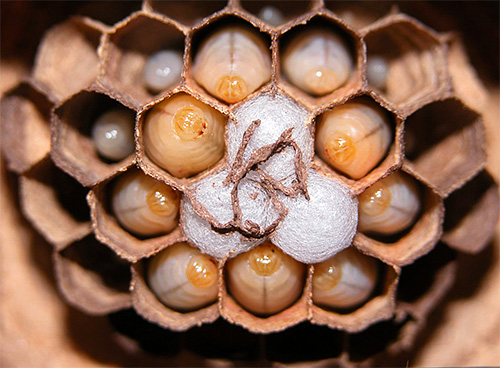
The entire hornet colony develops to a period of swarming, which occurs in late summer and early autumn. By this time, young males and reproducible females hatch from eggs. After swarming and mating, the males die, and the females find shelters for hibernation and hide in them in order to begin the life cycle again in early summer.
Thus, the entire life of hornets fits only in a small time period - the warm season. For the winter, the nest dies out, and only females of the entire many thousands of families remain.
In the photo - an example of such an empty nest:
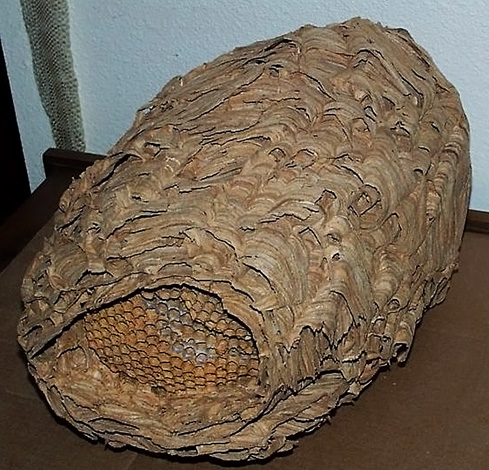
Thunderstorm of all bees
The greatest hornet brings the most trouble to Japanese beekeepers. Honeybees (usually European varieties, more industrious and less aggressive) are a real delicacy for hornets. However, the prey is not only bees, but also the honey they produce, which the giant predator feeds upon the destruction of the hive.

It is interesting
A single giant hornet can kill up to thirty bees in a minute, and a group of 30-40 “aggressors” will destroy a bee family of 20-25 thousand individuals in a few hours.
If the reconnaissance hornet finds a dwelling hive with bees, it leaves odorous marks near it, and upon returning to the nest, indicates to its brethren the way to dainty. After that, the horror killers are already a whole detachment sent to the ruin of the hive.
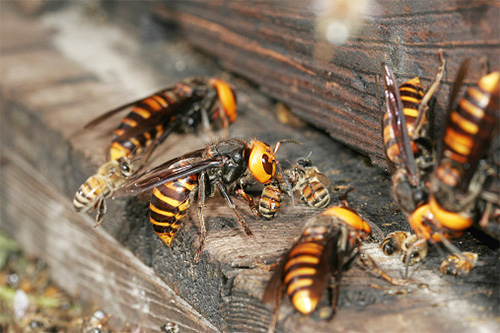
In fairness it is worth noting that some species of bees, in turn, also have a unique mechanism for dealing with hornets. However, he gives the result only with a small number of attackers. If hornets attack in significant numbers, the bees, alas, are powerless.
So, how does the bee protection mechanism work? The defense of the hive consists of several stages:
- at the very beginning, when a giant hornet tries to enter a hive, several bees stick it around;
- then, others sit on them, and this goes on until a huge ball of bees grows up around 30-35 cm in diameter around the hornet;
- parallel to this process, all the defenders of the hive are actively moving their wings, directing the air inside the ball - towards the aggressor - and heating it to 46-47 ° С destructive for the hornet (the bees themselves can withstand heating up to 50 ° C).

The result of all these efforts is the death of an attacking predator from overheating for about one hour.
Despite this seemingly effective mechanism, it is not able to cope with a whole detachment of winged killers of the bee. That is why the Japanese huge hornet is considered the cause of serious losses of beekeeping farms in this country. The owners and workers of apiaries are trying with all their might to destroy the nests of hornets near the places where honeybee hives are located.
Nevertheless, the struggle of beekeepers against the insect-enemy often ends up losing: a huge hornet, due to its size, can fly away in search of food to a distance of 10 km from its nest, and the victim himself can pursue up to 5 km.Therefore, despite all the efforts of man, the destruction of the nests of a giant predator often does not give pronounced results in protecting apiaries.
How poisonous is the huge hornet?
The huge Japanese hornet is one of the most venomous among its relatives. And the matter here is not only in the toxicity and specificity of the poison, but in its quantity with which the insect can “reward” its victim: one portion of toxins from the huge Japanese hornet is almost one and a half times larger than its ordinary European counterpart.
It is worth paying attention to the fact that, for all its poisonousness, a huge hornet is hunted mainly with the help of its jaws. Sting and poison are used only when fighting the largest and most dangerous victims, when the giant is “not sure” of its strength, or when it is defending itself.
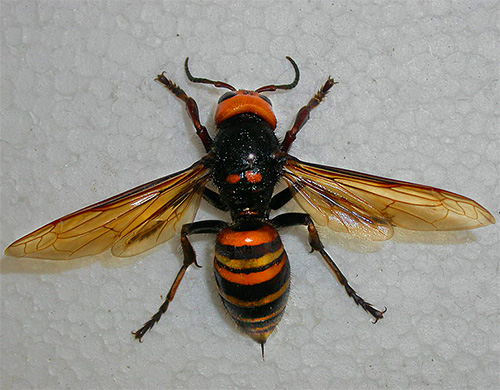
Interestingly, the usual honey bee, when bitten, injects much more poison into the wound than even a hornet. However, it often leaves its sting at the bite site, coupled with a special reservoir of poison, whose muscles continue to contract for a long time. The hornet never leaves its sting in the wound (its sting is not jagged, unlike the sting of a bee).
The photo below shows the sting of a bee:

And this is how the sting of a hornet looks like:
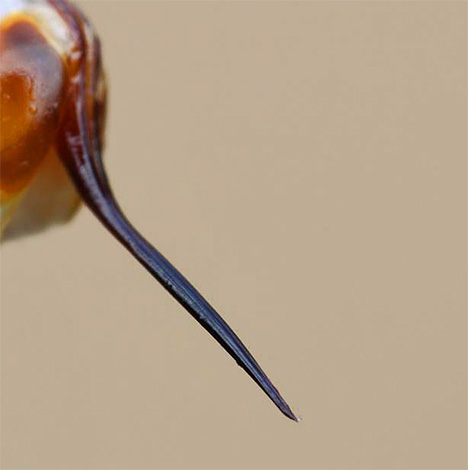
The bite of a huge Japanese hornet is truly amazingly painful. It is felt immediately, as soon as the giant has inserted a sting under the skin. Usually, within a few seconds, swelling appears at the site of the bite, with intense throbbing pain and inflammation.
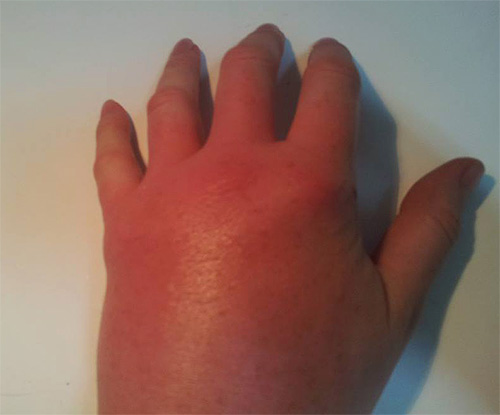
After about half an hour, more distinct and serious symptoms of poisoning develop - dizziness, rapid heartbeat, a sharp increase in body temperature. That is why a stung person needs careful observation - in some cases, these manifestations of allergy can almost instantly turn into a threat to life.
It is interesting
The length of the sting Japanese giant hornet - more than 6 mm. For the introduction of it under the skin of an insect does not necessarily sit on the person, it can do it on the fly, and many times.
In especially insect-sensitive people, banal, seemingly, edema is capable of turning into a strong allergic reaction with an increase in lymph nodes, nausea and angioedema.
Quite often after such bites, anaphylactic shock is observed in victims, sometimes fatal.If a person is stung by several hornets at once, he may develop a huge edema with abundant hemorrhages and necrosis of a part of the tissue in the affected areas of the body.
Feedback
«Hornet bitten me for the first time in the early summer of 2011, when I was working in my garden. The pain was terrible, as if a palm was doused in me with molten lead. I shook the hornet out of my hand and tried to suck the poison out of the wound, but this did not work. I had to go to the hospital. As I got to her, my condition worsened a lot. The whole arm swelled to the elbow, I was beginning to feel hot, my heart was pounding. Already in the hospital I was given some fast-acting drugs, and I began to get better. Two days later, I left home, and my hand stopped hurting only after 12 days. ”
Isimi Thomas, Sima
Despite all the horrors that the bite of a giant Japanese hornet threatens, in general it is much less aggressive and more calm than, say, a common wasp or a bee. It is the man who almost always provokes the bite of this huge predator when it intentionally tries to reach the nest or accidentally touches an insect. In all other cases, giant hornets in Japan do not represent a direct threat to humans, and when meeting with them one can easily disperse without consequences.
Interesting video: bees protect their hive from the hornet invasion
Japanese huge hornet against scorpion - who wins?


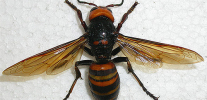

In the Primorsky Territory, they were brought on ships long ago ... Personally in Nakhodka, he defended two beehives from nine thieves.Bees were killed, scary to remember.